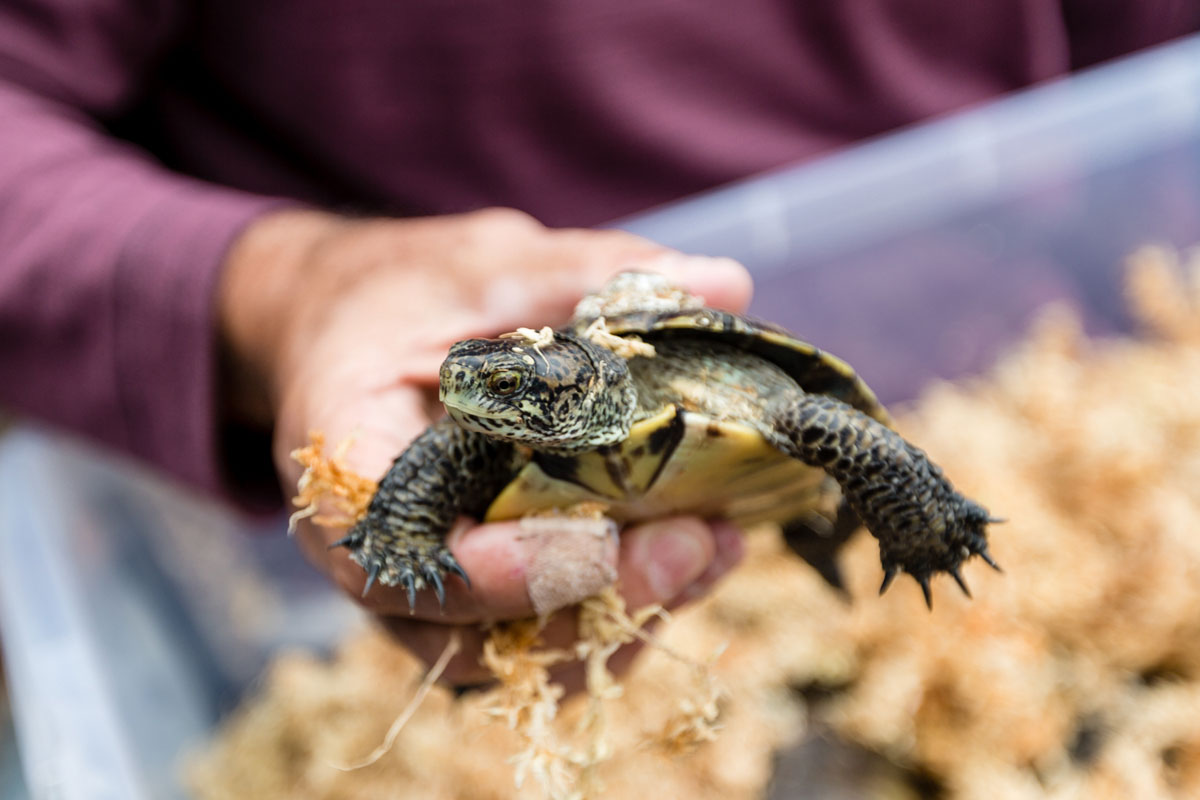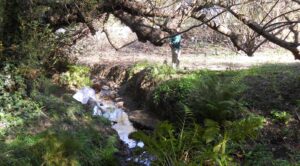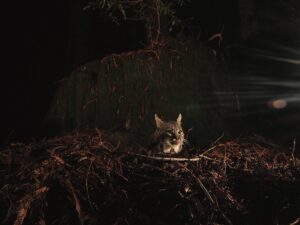If you remember the Presidio’s Mountain Lake of 15 years ago, you remember the algae blooms in summer and the dead fish floating in the lake. To see the lake a few weeks ago, as over 50 people did at a triumphant restoration event at the outdoor classroom, is to see something else entirely: a restored place clean enough to host Western pond turtles. Which is what the spectators were there to see: the second and final release of turtles into the lake, a last chance to see the turtles off, and perhaps a last chance to see a Western Pond turtle up close outside of a zoo.
The only time the turtles can really be seen in the now healthy lake is when they’re basking, said Jessie Bushell, the director of conservation at the San Francisco Zoo, but there is one female turtle who likes to bask on the floaters near the beach on the south shore of the lake on sunny days.
“This turtle release is symbolic of so much transformation,” said Michael Boland, chief of planning, projects, and programs at the Presidio Trust. Mountain Lake, he said, is not just about Mountain Lake, it’s about how the environment is managed: “Nature survives in cities because of people.”
Which, said Sonoma State lecturer Wendy St. John, is one reason the project has succeeded. People around the lake have rallied to its restoration. “This is their neighborhood, not just a touristy area,” St. John said. “It’s been a community effort.”
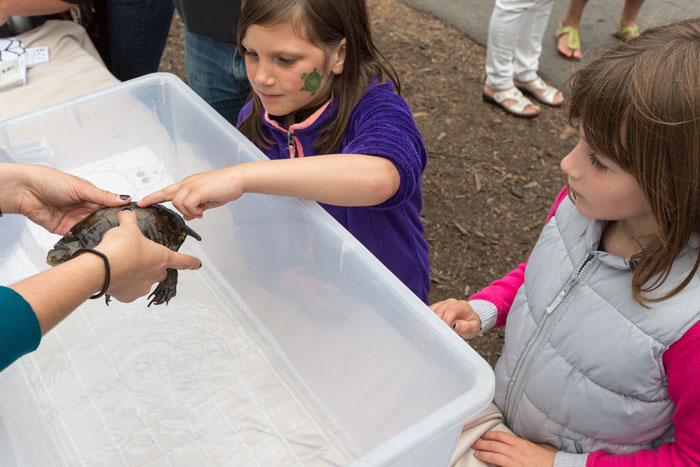
Along Mountain Lake Trail, adjoining the outdoor classroom, were booths from the National Park Service, the Presidio Trust, and the San Francisco Zoo, many with activities for children, ranging from reptile trivia to paper shell coloring. The zoo table had empty turtle shells to touch, and one not-empty turtle shell containing Blondie, the oldest Western Pond turtle in the United States, who has lived at the San Francisco Zoo since 1969.
The restoration at Mountain Lake has a kid-friendly component, but it has also been a living laboratory for the scientists. When Dana Terry of Sonoma State released Western Pond turtles into the lake two months ago, he was experimenting with different methods of releasing turtles back into the environment, and whether or not one way or another is more stressful for the turtles. Some turtles were released directly into the lake with no restrictions on movement, and some turtles were released after a period of acclimation in an enclosed area of the lake.
The results after two months: turtles that had a couple weeks to acclimate tended to disperse throughout the lake. Turtles released with no period of acclimation tended to clump in the area in which they were released.
The second turtle release at Mountain Lake was a repeat of the experiment.
St. John said it wasn’t necessarily a problem that some of the turtles didn’t disperse, but it could become an issue from a competition standpoint. She suspects that the turtles released with no acclimation period will eventually acclimatize and use the whole lake.
The crowd was directed by Jason Lisenby of the Presidio to head from the outdoor classroom to the eastern shore where the turtles would be departing. From behind the wooden railings, the south beach was also visible with spectators lining the lake or standing on the stairs leading down to the beach. Children were gently urged to the front, and one grandmother pointed out the white mesh enclosure on the West Shore buffer to her young granddaughter, who was straining to peer over the fence.
“Do you see that cage? That’s where they are,” she said. The 15 turtles in the cage had been acclimating for three weeks, while another group of 15 turtles made its way through the crowd on the east shore in a large plastic container. The gate leading to the lake was opened, and the turtles disappeared through the trees on their way to the canoe that would take them across the lake. As the canoe appeared from behind the trees, people yelled, “Bon voyage,” and the two men wearing orange lifejackets in the boat turned and waved. A murmur went through the crowd as Terry, waiting in the hip-high water next to the cage, lifted the white mesh lid of the enclosure as the canoe approached.
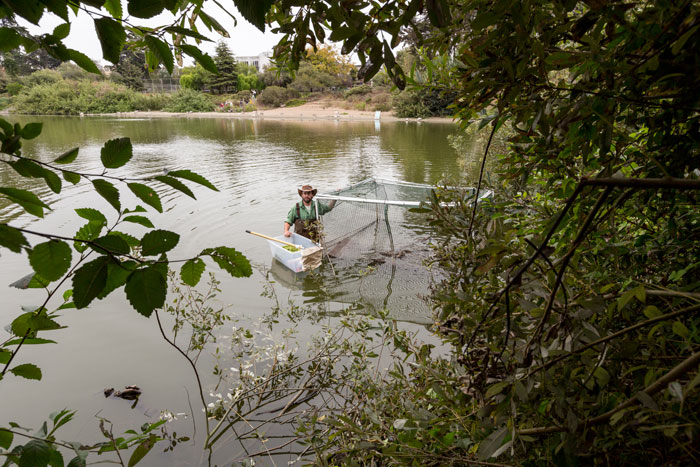
Although alerted by Lisenby that “science isn’t always a spectator sport,” and that once the turtles were in the boat, it would be difficult to see what was going on, numerous people did stick around to watch the canoe reach the other side of the lake.
One man joked, “They should hold signs up saying ‘We are now weighing turtles, we are now releasing turtles.’”
Despite the drought and the recent scorching weather – neither one good for turtles — there is hope for the Western Pond turtles because of the potential for El Nino rains, said Bushell. St. John agreed.
“El Nino, bring it on!” St. John said as people began to disperse on the east shore.
“But bring it on gently,” Lisenby added. “Over many days.”
When the turtles were recaptured using their telemetry devices to see how they were doing, they had gained weight. And the zoo and its partners have just received a grant through the Association of Zoos and Aquariums to extend the project at Mountain Lake — meaning that in the future, the turtles can be tracked by GPS. Bushell said she hopes that the Mountain Lake project will work as a “model or reference for future projects.”
But it’s really only the beginning. As more turtles begin using more of the lake, they can determine which areas are better for food and help provide better habitat, Bushell said. St. John also hopes that in three to five years, the females will be nesting, which would provide an opportunity to study nesting behavior.
The Mountain Lake restoration is making a huge difference for the community and for the Western Pond turtle; there will be turtles in the lake for the next generation. “A world without turtles is like a world without elephants and tigers,” Bushell said.

